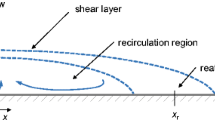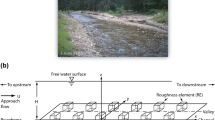Abstract
The turbulent structure of the backward-facing step flow, including the reverse flow region, in open-channel flows was investigated by making use of two sets of two-component Laser Doppler anemometers (LDA). The turbulence characteristics and reattachment properties were revealed. The time-averaged reattachment length was dependent on both the Reynolds number and Froude number in open-channel flows. In particular, it should be noted that the reattachment length became smaller in supercritical flows than in subcritical flows. The instantaneous reattachment point moved over a distance of the time-averaged reattachment length. This suggested strongly that a coherent structure of the kolk-boil vortex might be generated due to the unsteady and low-frequency motions of the reattachment point.
The structures of dynamic pressure and shear stress were analyzed on the basis of the momentum equation. These calculated values coincided well with the experimental values measured by the present LDA system. The separated step flow and its recirculation in open-channel flows were similar to that in boundary-layer and duct step flows. But, the former was more complicated than the latter, because the pressure was more relaxed by the existence of the free surface.
Next, the spectral analyses of pressure and velocity fluctuations revealed that a coherent low-frequency motion existed near the reattachment of the step. In order to reveal the coherent structures in the separated shear layer of the step flows and also in the downstream of the reattachment point, the space-time correlation measurements of the velocity-pressure and velocity-velocity combinations were conducted by using two sets of the Laser Doppler anemometers and the pressure transducer. Quasi-pe- riodic trains of vortical structure were generated due to the Kelvin-Helmholtz instability in the same manner as in the mixing layer, and they were convected toward the reattachment point. The possibility was discussed that these mixing-layer type coherent vortices might trigger a shedding of the large-scale horseshoe vortex from the reattachment point in open-channel flows. Then, this horseshoe vortex could have developed up to the free surface and become boil vortex, which was observed in actual rivers and estuaries.
Access this chapter
Tax calculation will be finalised at checkout
Purchases are for personal use only
Preview
Unable to display preview. Download preview PDF.
Similar content being viewed by others
Abbreviations
- C p ≡ 2(P−Ρ 0 )/ϱU 2 max :
-
wall pressure coefficient
- Fr ≡ \(Fr\equiv U_m/ {\sqrt gh}\) :
-
Froude number
- f :
-
predominant frequency in spectrum
- H s :
-
step height
- h :
-
flow depth
- Δh ≡ (h−h 0 ):
-
deviation from initial
- flow depth at x = 0 I r :
-
reverse-velocity intermittency
- P :
-
mean pressure
- P 0 :
-
mean wall-pressure at initial section, x = 0
- ΔΡ dynamic pressure = deviation from hydrostatic pressure p :
-
pressure fluctuations
- Re ≡ U m ·h/v :
-
Reynolds number
- U, V :
-
mean velocities in x, y directions
- U m :
-
mean bulk velocity
- U max :
-
maximum mean velocity at initial section, i.e. X = 0
- u, v :
-
turbulent velocity fluctuations in x, y directions
- \(u'\equiv{\sqrt u^2}, v'\equiv{\sqrt v^2}\) :
-
turbulence intensity
- X r :
-
time-averaged reattachment length
- x, y :
-
streamwise and vertical coordinates, respectively
- θ :
-
channel slope angle
- φ ≡ h 2 /h 1 :
-
conjugate water depth ratio or expansion ratio
- ψ :
-
stream function
- \(\tau \equiv -\varrho \overline {uv}+\mu \partial U/ \partial y\) :
-
shear stress
- τ :
-
otherwise, time lag in correlation function
- τ 0 :
-
wall shear stress
- suffix 1:
-
upstream section from the step
- suffix 2:
-
downstream section from the step
References
Armaly, B. F., Durst, F., Pereira, J. C. F., Schönung, B. (1983): Experimental and theoretical investigation of backward-facing step flow. J. Fluid Mech. 127, 473–496
Ashida, K. (1962): On hydraulics of tranquil flow through channel expansions and its contributions to practical problems. Annuals, Disaster Prevention Research Institute, Kyoto University, 5-A, 223–251 [in Japanese]
Bradshaw, P., Wong, F. Y. F. (1972): The reattachment and relaxation of a turbulent shear layer. J. Fluid Mech. 52, 113–135
Cherry, N. J., Hillier, R., Latour, M. E. M. P. (1984): Unsteady measurements in a separated and reattaching flow. J. Fluid Mech. 144, 13–46
Coleman, J. M. (1969): Brahmaputra River; channel process and sedimentation. Sediment. Geol. 3, 129–239
Durst, F., Tropea, C. (1983): “Flows over Two-Dimensional Backward-Facing Steps,” in IUTAM Symp. on Structure of Complex Turbulent Shear Flow, ed. by R. Dumas and L. Fulachier (Springer, Berlin, Heidelberg) 41–52
Eaton, J. K., Johnston, J. P. (1982): “Low Frequency Unsteadyness of a Reattaching Turbulent Shear Layer,” in Turbulent Shear Flows 3, ed. by L. J. S. Bradbury, F. Durst, B. E. Launder, F. W. Schmidt, J. H. Whitelaw (Springer, Berlin, Heidelberg) pp. 162–170
Etheridge, D. W., Kemp, P. H. (1978): Measurements of turbulent flow downstream of a rearward- facing step. J. Fluid Mech. 86, 545–566
Jackson, R. G. (1976): Sedimentological and fluid-dynamic implications of the turbulent bursting phenomenon in geophysical flows. J. Fluid Mech. 77, 531–560
Kim, J., Kline, S. J., Johnston, J. P. (1978): Investigation of separation and reattachment of a turbulent shear layer: flow over a backward-facing step. Report MD-37, Dept. of Mech. Eng., Stanford University
Kinoshita, R. (1984): Present status and future prospects of river flow analysis by the aerial photograph. Proc. Jpn. Soc. Civil Eng. No. 345, pp. 1–19 [in Japanese]
Kiya, M., Sasaki, K. (1985): Structure of large-scale vortices and unsteady reverse flow in the reattaching zone of a turbulent separation bubble. J. Fluid Mech. 154, 463–491
Kuehn, D. M. (1980): Effects of adverse pressure gradient on the incompressible reattaching flow over a rearward-facing step. AIAA J. 18, 343–344
Ludwieg, H., Tillmann, W. (1949): Untersuchungen über die Wandschubspannung in turbulenten Reibungsschichten. Z. Angew. Math. Mech. 29, 15–16
Matthes, G. H. (1947): Macroturbulence in natural stream flow. Trans. Am. Geophys. Union 28, 255–265
Müller, A., Gyr, A. (1986): On the vortex formation in the mixing layer behind dunes. J. Hydraulic Res. IAHR 24/5, 359–375
Nakagawa, H., Nezu, I. (1987): Experimental investigation on turbulent structure of backward-facing step flow in an open channel. J. Hydraulic Res. IAHR 25/1, 67–88
Narayanan, M. A. B., Khadgi, Y. N., Viswanath, P. R. (1974): Similarities in pressure distribution in separated flow behind backward-facing steps. Aeron. Q. 25, 305–312
Nezu, I. (1987): “Open-Channel Flows (Chapter 8),” in Handbook of Fluid Mechanics, ed. by Jpn. Soc. Fluid Mech. (Maruzen Publ.) pp. 253–275 [in Japanese]
Nezu, I., Nakagawa, H., Tominaga, A. (1985): “Secondary Currents in a Straight Channel Flow and the Relation to Its Aspect Ratio,” in Turbulent Shear Flows 4, ed. by L. J. S. Bradbury, F. Durst, B. E. Launder, F. W. Schmidt, J. H. Whitelaw (Springer, Berlin, Heidelberg) pp. 246–260
Nezu, I., Rodi, W. (1986): Open-channel flow measurements with a laser doppler Anemometer. J. Hydraulic Eng. ASCE 112/5, 335–355
Nezu, I., Nakagawa, H. (1987): “Evaluation of Shear Stress in Open-Channel Step Flows,” in Fluvial Hydraulics, ed. by W. R. White, 22nd Congress of IAHR, Lausanne, pp. 219–220
Nezu, I., Papritz-Wagner, B., Scheuerer, G. (1988): “Numerical Calculations of Turbulent Open Channel Backward-Facing Step Flows,” 3rd Int. Symp. on Refined Flow Modelling and Turbulence, IAHR, Tokyo, pp. 183–190
Raudkivi, A. J. (1963): Study of sediment ripple formation. J. Hydraulics Div. ASCE, HY-6, 15–33.
Roshko, A., Lau, J. C. (1965): “Some Observations on Transition and Reattachment of a Free Shear Layer in Incompressible Flow,” in Proceedings of Heat Transfer and Fluid Mechanics Institute, ed. by A. F. Charwet et al. (Stanford University Press)
Tani, I., Iuchi, M., Komoda, H. (1961): Experimental investigation of flow separation associated with a step or a groove. Aeron. Res. Inst. University of Tokyo, No. 364, pp. 119–137
Author information
Authors and Affiliations
Editor information
Editors and Affiliations
Rights and permissions
Copyright information
© 1989 Springer-Verlag Berlin Heidelberg
About this paper
Cite this paper
Nezu, I., Nakagawa, H. (1989). Turbulent Structure of Backward-Facing Step Flow and Coherent Vortex Shedding from Reattachment in Open-Channel Flows. In: André, JC., Cousteix, J., Durst, F., Launder, B.E., Schmidt, F.W., Whitelaw, J.H. (eds) Turbulent Shear Flows 6. Springer, Berlin, Heidelberg. https://doi.org/10.1007/978-3-642-73948-4_26
Download citation
DOI: https://doi.org/10.1007/978-3-642-73948-4_26
Publisher Name: Springer, Berlin, Heidelberg
Print ISBN: 978-3-642-73950-7
Online ISBN: 978-3-642-73948-4
eBook Packages: Springer Book Archive




